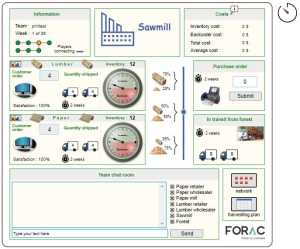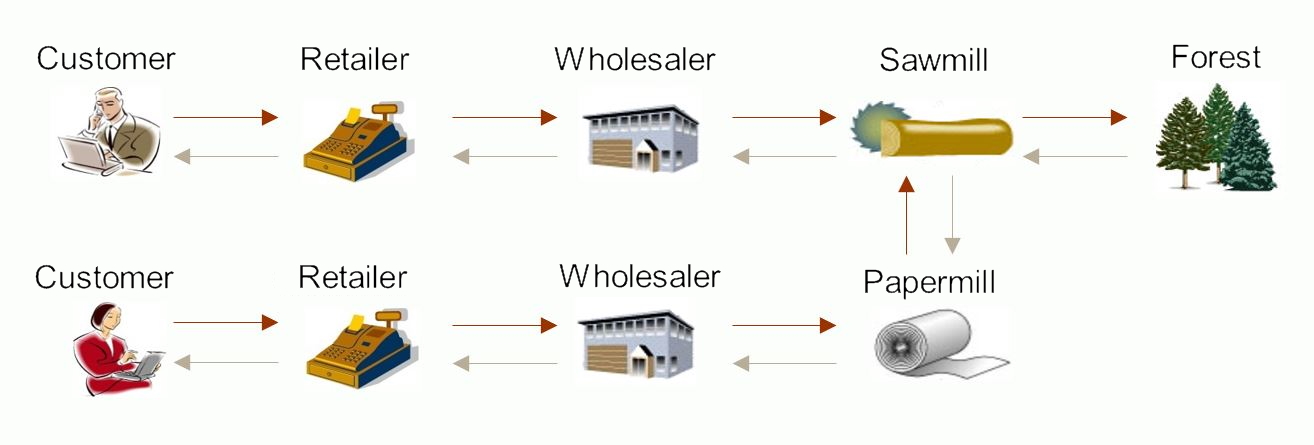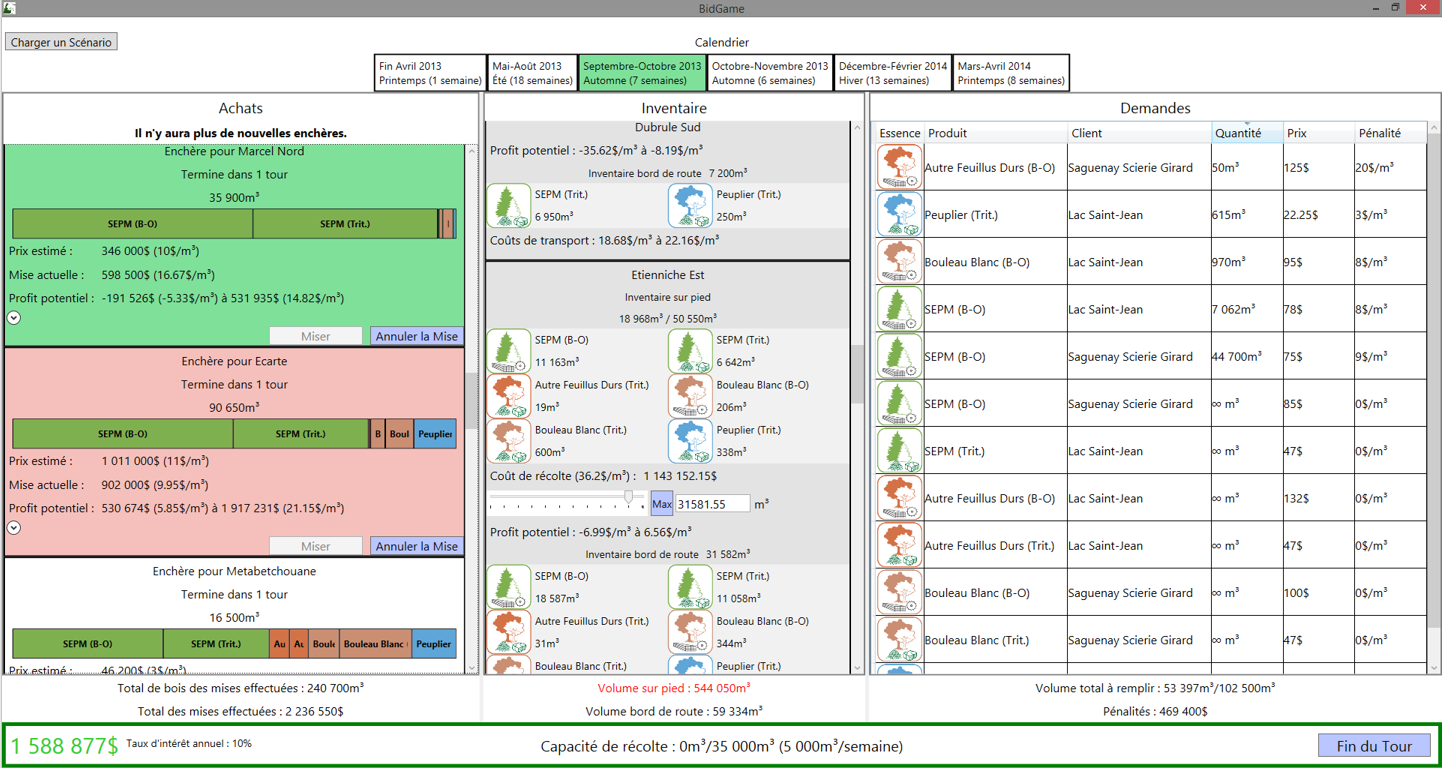Contact us if you want to know more about our educational games.
The forest products industry is one that includes all the mills that produce and transform wood and wood products. In this industry, the value creation cycle from the forest to the end customer is long and complex.
 Each enterprise in the value creation network is an independent decision making unit and this can result in a lack of synchronization of operations. However, information is an important tool when managing the value creation network. Incomplete and incorrect information causes delivery problems (the right products available at the right place and at the right time) and customer satisfaction.
Each enterprise in the value creation network is an independent decision making unit and this can result in a lack of synchronization of operations. However, information is an important tool when managing the value creation network. Incomplete and incorrect information causes delivery problems (the right products available at the right place and at the right time) and customer satisfaction.
The Wood Supply Game simulates the operations in the forest product supply chain in order to demonstrate the dynamics at work in the value creation network and show the importance of information sharing between enterprises.
Each game is played with a maximum of 7 people, each responsible for the management of one enterprise in the network. Each round in the game represents one week. Each game is between 25 and 50 weeks long. The supply chain is represented by different downstream business units of the end customer. These units are: the forest, the sawmill, the paper mill, the distributors and the retailers. The divergent nature of the forest products industry supply chain is simulated by dividing the material produced at the sawmill into chips and lumber.

Documentation: https://forac-web-03.forac.ulaval.ca/woodSupplyGame/AideJeuBois/EN/indexEN.htm
Game start page: Canadian Server / European Server / Asian Server
Papers:
- Sophie D’Amours, Philippe Marier, Mikael Rönnqvist, Riadh Azouzi, Dag Fjeld (2017) Game—The Online Wood Supply Game. INFORMS Transactions on Education 18(1):71-87. https://doi.org/10.1287/ited.2017.0174
- Oshadhi K. Herath, Banusha Aruchunarasa, H. Niles Perera, (2021) Supply Chain Learning Through the Online Wood Supply Game: A Sri Lankan Case StudyR.M. Chandima Ratnayake, 2021 IEEE International Conference on Industrial Engineering and Engineering Management (IEEM).
- Erland Ystrom Haartveit and Dag Fjeld, Experimenting with industrial dynamics in the forest sector – a beer game application.
Introduction
The transport game is an online educational game focusing on hierarchical procurement planning in a simulated forest supply chain with multiple companies. The purpose is to provide an understanding of the importance of individual decisions and their medium- to long-term impacts on the entire supply chain. The game is comprised of four phases, each simulating hierarchical decision-making when three competing companies (i.e., the game players) are making simultaneous decisions on the available resources. Each game phase also requires concurrent collaboration and competition. The phases represent different planning levels from long-term to short-term planning, considering the collaboration concept within the supply chain.
The first phase is to purchase enough supply for a given demand. A second phase is to make strategic wood exchanges or use so-called wood bartering. In this phase, companies can exchange far away volumes to much closer ones. A third phase is later to make a tactical destination planning of the available volumes at supply points to a set of demand point or mills. The fourth phase in the transport operational planning. The objective is to use the destinations to find backhaul routes to minimize the unloaded distance. A normal destination is based on driving loaded in one direction and unloaded in the other direction. This gives an efficiency of only 50%. A backhaul route makes a loaded transport and then drives a short distance to pick up another load for transport to a mill close where the first load was picked up. The aim of this last phase is to try to find backhauls that reduces the unloaded distance.
Tutorial
Game start page: https://forac-web-03.forac.ulaval.ca/TransportGame/
Material:
- Presentation (ppt, 8Mo)
- Flash cards (pdf, 800Ko) on 1 page / on 2 pages
Papers:
The next generation of teaching tools for forestry students
The Virtual Wood Supply Arena (VWSA) is an on-line training tool for managing roundwood purchase, production and transport in CTL supply systems. The training environment simulates 12-week periods with monthly mill delivery goals while handling weekly weather and site trafficability for harvesting and hauling.
The VWSA is designed to come as close to reality as possible in an on-line environment. It includes three roles per company (purchase, production and transport managers) managing 10 harvesting teams and 10 trucks over 4 supply regions and 2 climate zones (highlands, lowlands). Deliveries of 5 assortments are managed to 5 mills (2 pulp mills and 3 saw mills). Team KPIs include monthly delivery precision per mill assortment, capacity utilization, relocation and hauling distances. The user interfaces are presented below.
In the context of university training, the VWSA provides a high level of realism and accelerated experience-based learning. Participants respond to both typical and atypical weekly variation in the operating environment and learn effective geographical allocation of resources, as well as the adaptive management of road-side stocks to ensure secure deliveries, regardless of trafficability challenges.

Tutorials
Short instructional videos for working in the Virtual Wood Supply Arena :
|
Game start page: https://forac-web-03.forac.ulaval.ca/VirtualWoodSupplyArena/
Paper:
Collaboration among and between supply chains is attracting an increasing interest from academic and industrial communities. This is seen as a new approach to increase the value created through better cross-chain coordination. However, most agree that establishing efficient and sustainable collaborations requires highly skilled and competent people. Business games are often used for developing complex competences. This is the case for the collaboration game because the participants integrate advanced game theory knowledge as well as develop their negotiation skills. Moreover, it also provides insight into how differently the bargaining power can be determined based on the size and location of the companies.
The game is played with each player representing a single forest company responsible for planning transport between a set of supply points and a set of industries. The challenge for the players is to find one or several efficient coalitions (a set of companies working together) among the companies and to share the benefits and costs of the collaboration. If companies work in a coalition, they simply treat their supply and demand as common and can find a transportation or distribution solution that lowers the overall transportation cost. After the game is played, the closing discussion always brings up the challenges of building long-term relationships and provoke reflection on other aspects of long-term relations such as trust, communication, coordination mechanism, and contracts.
To be efficient, business games need to be simple and meaningful. The game developed focuses on two aspects of collaboration in logistics: coalition building and sharing mechanism. The game is simple to run and explain. Moreover, the game builds on an industrial case study providing a meaningful background in terms of the data (e.g., maps, costs, distances and volumes) and human behavior.

Maps describing each of the companies. Green areas describe supply areas and red circles industries with demand.
Access to online version: https://forac-web-03.forac.ulaval.ca/CollaborationGame/
Material:
- Players' instruction: 4 companies case | 5 companies case (docx, 350 ko)
- Presentation, 5 companies case [in French] (pdf, 1 126 ko)
- Materiel to print, 5 companies case [in French] (zip, 763 ko)
- Excel file for input of results: 4 companies case / 5 companies case / filled sample [in French]
Papers:
Serious game to study betting strategies during Quebec forest auctions with a view to maximizing profits.
The auction simulator allows you to:
- Bid on different lots of wood at auction (purchases)
- Manage the harvest of your forest inventory (inventories)
- Meet market demands from defined products (demands)
The game is based on fully configurable scenarios which allows to replay real BMMB auctions. It was developed by Guillaume Morin, Alexandre Morneau and Rémy Huot, in collaboration with the Quebec Federation of Forest Cooperatives, between 2017 and 2019.

Material:
- Bidgame user guide [in French] (pdf, 1.1 Mo)
Memoir:
- Stratégies d’approvisionnement dans un contexte d’enchères de bois [in French] (pdf, 6.2 Mo)